If you purchase an independently reviewed item through our site, we earn an affiliate commission. Read our affiliate disclosure.
Of all the insects in existence, bees are some of the most organized, territorial, and valuable. They are organized in colonies that are self-sufficient and self-propagating. The honey bee colony in particular is well-known for its effective defense against disease. Bees have a superior immune system, one that can be compared to that of vertebrate animals. They also do an excellent job of defending the hive against invaders through impenetrable walls built on hive crevices and openings. Bees will also physically remove parasites and other pathogenic agents from the hive. Another defense mechanism employed by the bee colony is the use of propolis to cover huge invaders which have died in the hive. However, despite this self-defense mechanism, they are still prone to honey bee diseases.
The Importance of a Healthy Bee Colony
Every beekeeper strives to keep a healthy and productive bee colony for a good reason. Healthy and productive bees are easier to maintain and are highly profitable. Therefore, to achieve this, the frequency and prevalence of disease should be reduced. As a summary, we present a table with some of the common bee diseases, causes, and signs. Further below the article we present a summary of the most common honey bee diseases.
Type |
Cause |
Signs |
| Varroa mites | Caused by Varroa destructor | Adult mites can be seen. Bees with deformed wings are also a sign of Varroa mite infestation
Short abdomens in adult bees Deformed legs Reduced adult population |
| Tracheal Mites | Caused by Acarapis woodi | Morbidity |
| Nosema | Caused by Nosema apis | Deformed abdomens and diarrhea |
| American Foulbrood | Paenibacillus larvae | Odorous smell in brood, abnormal colored larvae
Sunken brood |
| European Foulbrood | Melissococcus pluton | Foul smell in brood and discolored larvae |
| Sacbrood | Virus | Curled brown larvae |
Type of Honey Bee Disease – Bacterial
American Foulbrood Disease
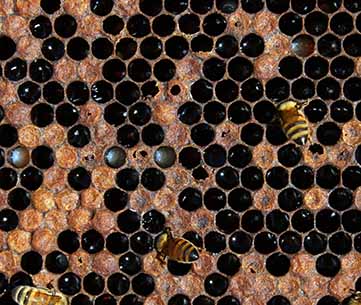
The American Foulbrood (AFB) is the most common bacterial disease affecting honey bees globally; needless to say it is the most destructive. It is prevalent in temperate and sub-tropical regions, that is, regions where there is abundant sunlight and where temperatures are high all through the year. It is a contagious disease and the pathogenic bacterium remains dormant for up to 50 years. American Foulbrood is a disease that affects the queen, drone, and even the worker bee larvae. The adult bees are resistant to the disease. The disease takes two forms: vegetative form or spores.
Some of the symptoms of American Foulbrood include: sealed and unsealed brood cells that are scattered and irregular. A healthy brood cell is compact and well arranged. Dead larvae and pupae is also another sign of the AFB disease.
To control this disease a wide variety of techniques are employed. One is the inspection and complete removal of infected foulbrood and hive materials. A poisonous gas is normally used to kill the bees, for instance, sulphur powder. Thereafter the entire bee colony and hive materials are collected and dumped on a hole then burned using kerosene. This method is quite costly given the materials required for destruction. As second remedy for AFB is the direct artificial swarm method. Others include the use of chemicals.
European Foulbrood Disease
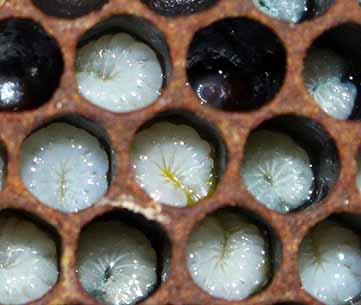
The name of this bee disease is quite misleading since it is not confined to Europe alone. In terms of prevalence this disease is less virulent when compared to AFB. Some of its symptoms include dead larvae. Five to four day old larvae die within the bee colony. This disease is regarded as a stress disease in the honey bee colony. It occurs mostly during spring and early summer and does not manifest as spores. The disease can be acquired via contaminated brood food and can spread rapidly within no time around the gut of the larva. Scattered pattern of unsealed and sealed brood is also another sign of the disease.
To control the disease, one has to consider how severe it is. Weak infection requires stimulation of the bee colony. Feed the bees with honey or sugar water and they will be stimulated to improve the hygiene within the hive. A spray of the honey combs with honey solution also works where the infection is weak. In case the infection is extreme, the infested brood combs should be removed so as to reduce the pathogens. Requeening also helps prevent the spread of the European foulbrood.
2. Type of Honey Bee Disease – Fungal
Chalkbrood Disease
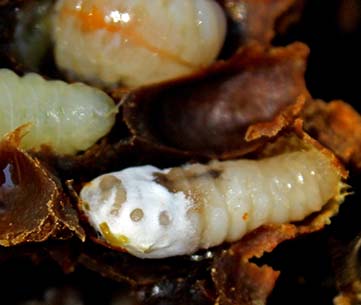
This is never considered a serious honey bee disease. It is however a problem is some countries such as Japan. The disease is caused by spore-forming fungus and usually affects the queen larvae, worker, and drone. The systematic disease begins when the fungus is ingested through the larval food. Spores develop in the bee larva’s hind gut. The vegetative growth remains dormant until the larvae are sealed in the cells. Later on, about 6 to 7 days from the day of sealing, mycelia bursts out of the gut walls and feast on the larval tissues for a period of 2 to 3 days, completely dominating the entire larva.
One of the symptoms of the Chalkbrood disease is the swelling of the dead larvae and a whitish mycelia covers the larvae. In severe infestation the sealed broods die and is dried up within the cell. Furthermore, infested combs make a rattling sound.
The main remedy for this disease is the hygienic behavior of the bees where the infested brood is removed by the bees. As the beekeeper stimulate the hygienic behavior of the bees by changing the brood rearing conditions. The hive size should also be perfectly fitting to the strength of the bee colony. The hive should also be well ventilated. This disease has no chemical control measures.
3. Type of Honey Bee Disease – Viral
Viral diseases are common in honey bees. They are widespread and differ in nature. They also cause a varying level of damage depending on factors such as; weather conditions, type of virus, the strength of a colony, and the strain of virus in question. The natural chitin body shell and gut coating of bees protects them against any infection. However, parasites that can penetrate the skin increase the bee’s susceptibility to infections.
Sacbrood Disease
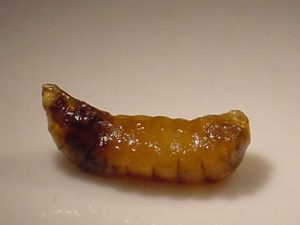
This is a well-known viral disease of honey bees. The disease was first discovered in Thailand in the year 1981. Currently it is spread across most countries globally. Reliable researches have even proven that the major distributors of the disease are the nurse bees. The young larvae get the disease through the worker bees’ brood-food gland secretions. The disease is prevalent during brood-rearing season and may not be noticed easily since it only affects a tiny percentage of the brood.
The Sacbrood disease is easy to notice once it has manifested. Disease larvae normally fail to pupate after 4 days. Instead, it remains within the cells with its head and thorax changing color. The color changes first off starts with white, then pale yellow, and eventually turn to dark brown. The skin of the larvae also toughens and its contents become watery. After a while the larvae dries out and remains loosely attached to the cell floor.
Sacrood disease has no chemical treatments. The bee colony normally recovers on its own. However, the beekeeper can help prevent or fight it by stimulating behavioral hygiene in the bee colony. The disease is more prevalent during stress periods such as food shortages, lack of food storage space, unhygienic hive conditions within the hive, other disease infestation and unbearable climatic conditions. One advantage that bees offer with regard to this disease is the fact that they can detect infected larvae quickly and remove them from the beehive.
4. Type of Bee Honey Disease – Protozoan
Nosemosis or Nosema Disease

This disease destroys adult bees, worker bees, drones, and even queens. It cripples the worker bees and they will be seen crawling and trembling within the entrance to the hive. It shortens the lifespan of the bees and tremendously weakens the strength of a bee colony. The Nosema spores are usually transmitted through water or food ingested by the honey bee. These spores develop and spread rapidly within the mid-gut of the bee. Plenty of these spores are released into the digestive tract for further elimination through fecal matter.
The symptoms of the disease are not easily visible unless the situation is extreme. Notable signs include swelling of the abdomen of infected bees and use of lab tests to identify some of its signs. To prevent the disease keep the colony healthy and ensure the bees are never stressed. The apiary should also be well ventilated. Honeycombs should also be changed after every two years.
Other Honey Bee Diseases
Paralysis
This disease affects adult bees and is caused by viruses. It is caused mainly by two common viruses: Acute Bee Paralysis Virus (APV) and Chronic Bee Paralysis Virus (CPV). Bees might also suffer from paralysis as a result of a number of factors, namely: fermented pollen consumed by the bees, pollen from certain plants such as laurel, buttercup, certain species of basswood, or rhododendron. Lack of pollen during brood rearing period also causes paralysis in the honey bee colony.
Bee Parasitic Mite Syndrome
This is mainly caused by viruses or varroa mites or a combination of the two. The bee larvae affected by this disease die at the prepupal or larval stage. The brood stretch out within the cells and their heads become slightly raised. Early stages of this disease can be identified by the white and dull deflated brood.
Colony Dead-Outs
This is not a disease in itself but it is a common occurrence in beekeeping at end of winter months. It refers to hives that have experienced the death of an entire bee colony. This is quite frustrating and expensive to handle given the kind of hard work that is devoted to building a bee colony. Conversely, if a dead out does not occur, the huge potential the bee colony has is invaluable. You can split hives, requeen, or even manage the colony so as to produce huge honey reserves. Nonetheless, the instance that dead outs occur serves as a learning point to the beekeeper. The main cause of a hive dead-out is wide and diverse. They are easy to identify and therefore an understanding of dead-out causes and signs can help the beekeeper alter his or her practices so as to minimize the frequency of dead-outs in the future.
Winter time is the season to check for signs of dead-outs and it seems daunting to do so since at this time temperatures are extremely low and bees do not leave the hive unless necessary. Therefore you first begin by evaluating the hive entrance. Check out the ground near the entrance to the beehive. If you see fresh dead bees it means that the hive is still alive.
You should also listen carefully to the hive for any humming sound. If unable to hear any buzz or sound it is time to wear the veil and open the lid. Check out for live bees and bring your ears close to the top bar to find out whether you can hear a buzzing sound. The bees might respond abruptly meaning the bee colony is alive. The removal of dead bees from the entrance also indicates that the bee colony is alive. You should also check the honey stores now that you have opened the beehive. If the bees require supplements then avail the emergency feed.
In the worst case scenario, you might find out that there is a dead-out. Do not allow grief to overwhelm you given the amount of effort and finances devoted to building such a colony. Instead, take your focus to the surviving hives and try to evaluate the root causes of the die-out. You can try to compare the hive conditions of the surviving and the dead ones. You will learn a lot which can help prevent this from happening in the future.
Some of the things to check for after a die-out include the following:
- The exact location of the cluster of dead bees. Identify whether it is at the top or lower side of the hive.
- Lift the hive boxes to check the weight of the affected hives. Open the boxes and check the honey stores. In some cases the bees may starve and plenty of honey existed a few inches away. This may be due to the extreme cold forcing the bees to curdle instead of leaving the brood to eat the honey.
- Check the bottom board. Look out for mice waste or any chewed material. Check out for Varroa mites as well. If you find any traces then you can understand the cause of the die out or rather the catalyst for the loss.
- Pick the dead bees and check out the presence of hive beetles or wax moths. A strong colony can withstand a few hive beetles. However, too many of hive beetles can result in a die-out. However, it is important to note that something else causes the weakened colony for the hive beetles to take over and annihilate an entire bee colony.
- Check out for deformed wings in the dead bees. This could mean the die out was caused by the notorious Varroa mite. If the deformed wings have a K-shape then that means the tracheal mite is the main cause of the die-out.
How to Keep off Pests and Diseases
Good hygiene practices in the apiary can help protect the beehive from pests and diseases. You can prevent pests and diseases from spreading to other hives and areas through acceptable hygiene practices in beekeeping. A routine check on the hives will also reduce the impact of pests and diseases in cases where pests and diseases are introduced to the hive by accident.
Keep pests and diseases away from your bee colony through the following:
Establish Standards of Safety
- Set and maintain high standards in your beekeeping venture. These should be written clearly and kept within a location that can been seen by anyone who visits your beekeeping enterprise.
- All staff and family members should be trained on the required standards. Visitors should also be trained before they enter the area where the hive or apiary is located.
- Beekeeping equipment should be disinfected and clothing changed between hives during honey harvesting. This can help prevent diseases and pests from spreading between hives. Remember, mites such as the Varroa can stay for so long in hives before being noticed. These can be transmitted from one hive to the other through clothing or bees transported in vehicles.
- Extraction facilities and apiary sites should be restricted. A clear sign should be erected showing the required standards and whoever fails to meet these standard barred from accessing the site. Vehicles and trucks used for beekeeping or ferrying beekeeping products such as supers, combs, and others should not be allowed to access extraction facilities and hive sites.
- Labeling is critical with regard to newly purchased beehives or used beekeeping equipment. You should also label infected hives and products. These should be sterilized so as to prevent pests and diseases from spreading to other beehives. These items should also be kept in one apiary and not spread across various apiaries so as to make it easy for monitoring and back-tracking in case of pest and disease outbreak.
- Central extraction plants or mobile extraction vans should be well secured to prevent bees from accessing them. This will help keep check on pests and diseases that might have accidentally ended up at these spots or also might be brought along by the bees from unsafe hives.
- Bees should be transported at night since at this time all the bees are in the beehive. This will ensure no bee can stray to other hives and hence helps curb the spread of pests and diseases. Loads should be also covered using a bee-net so as to keep the bees from escaping while on transit.
- You should avoid passing by another beekeeper’s apiary while transporting beekeeping equipment or products. Do not pick used beehive equipment from other beekeepers while transporting hive equipment or products as well.
Be Aware
- Acquaint yourself and all staff about the signs of beekeeping diseases and pests infestation. Engage with other beekeepers as well in efforts aimed at reducing diseases and pests in the apiary. Regular checks are also recommended and any signs should be reported. You should also check out colony strength and in case it has decreased, consult an apiary inspector.
- Avoid areas that have historically proven to be infested by hive pests and diseases. Areas with abandoned hives should also be avoided by all means.
Keep Swarming at Bay
- Swarming should also be kept on check so as to prevent diseases from spreading from one hive to another. Proper hive management can prevent bees from swarming even this is a natural phenomenon in bees. Some of the causes of swarming are known and hence it is easier to prevent bees from swarming. If unaware of these causes, it is recommended you familiarize yourself with them.
- Requeening the beehives regularly will help keep the colony strong and prevent it from dying out. A strong colony is in a better position to withstand pests and diseases. Robber bees that transmit pests and diseases cannot enter hives with strong colonies.
Know Your Suppliers
- Bees and beekeeping equipment should be obtained from apiaries or suppliers that are safe and reputable. This is the sure way to guarantee your bee colony is safe from beginning.
- A supplier should have a clear record of regular checks on bee pests and diseases. Furthermore, the vendor should avail a declaration that ascertains the equipment is free from pests and diseases.
- All beehives should be subjected to a thorough check for pests and diseases before purchase. A honey culture test (HCT) should also be undertaken on all beehives before making a purchase.
- Caution should be exercised while purchasing nucleus beehives. These are high risk and can be a source of brood diseases. They may harbor pests and diseases that might take several weeks to be identified. Instances where pests and diseases are present in nucleus beehives result in the transmission of these diseases and pests to other hives. The Varroa mite for example can stay hidden in nucleus hives for weeks and months without being detected. This will eventually be transported to other hives. You should therefore have the assurance that whichever nucleus you purchase is free from pests and diseases.
- Used beekeeping equipment should be well covered and safely stored so as to keep off robber bees. Hives that are no longer in use or dead hives on the other hand should be sealed at the entrance and all its components treated before being stored. This will help keep wax moths way.
Inspect Regularly
- Regular inspection should be conducted on brood and honey frames. Check out for any signs of pests and diseases. Laboratory tests of honey samples, brood combs, and bees can help identify early signs of pests and diseases then give longer lasting solution to the problem.
- Regular hive inspection is highly recommended. Any new bees should be isolated and checked. Regular checks on the hive will help identify early signs of pests and diseases so as to allow sufficient time for the beekeeper to treat and stop its spread.
- While working beehives, it is recommended that you focus on one beehive at a time. Once done, clean and disinfect your hands before proceeding to the next beehive. You might also use disposable gloves since this allows you to change them once done with one hive and use new ones on the next beehive.
- Beehive movements should be well-tracked and recorded so that it becomes easy to identify the source of pest or disease outbreak in case it occurs.
- Used beehives and supers should be properly covered while working on them them during the day so as to keep off robber bees.
- Frames should be labeled during management activities so as to ensure it is taken back to its rightful hive once done. This will avoid cross-contamination which normally spreads diseases and pests between beehives.
Use a Queen Excluder
- You cannot do without the queen excluder. This helps confine the queen in her rightful place and ensure the brood cells are not mixed with the honey cells. This ultimately helps identify some diseases such as American foulbrood. Once identified, it becomes easier to eliminate the disease and prevent it from spreading.
Take Care of Your Bees
- Bees should be fed using treated honey products so as to avoid the introduction of fungi and bacteria into the bee colony. Pollen fed to the bees should be irradiated. Other healthy feed supplements for bees are pollen substitutes and sugar syrup. These are normally safe since they are not made up of any beehive products.
- Abandoned or neglected hives are a major cause and transmitters of hive pests and diseases. A hive is regarded as neglected for a number of reasons: where more than 5% of the bees have died out, unbranded hives, poorly constructed hives that allow robber bees to infiltrate, hives that are not maintained, or appliances and used equipment that can be accessed by robber bees. Hives that are abandoned refer to any hive whose owner is unknown. Any abandoned, neglected hives or robbing beehives should be reported immediately to apiary inspectors or any nearby hive regulator. That is the best way to curb pest and diseases spread from such hives to other apiaries.
Wrapping up – Tips to Boost Hive Productivity
Bee diseases are a major cause of low hive productivity and a declining bee population. Therefore, to boost hive productivity means fighting these diseases to the core. There are also some other ways you can boost beehive productivity explained below:
- Avoid toxins – toxic nectar and pollen have been a serious threat to beehives for many years and it still is a challenge. Hives should be placed in regions that are not prone to chemical pollution. Hive pests should also be treated organically instead of using chemicals. Avoid the use of synthetic miticides and stay away from pesticide exposure. Old combs should also be used in rotation basis.
- Parasites should be suppressed – parasite resistant stock can win over notorious hive pests. Where possible use natural treatments for hive pests. Continually monitor mite levels and act accordingly. The Varroa mite is particularly too common and can only be managed through regular monitoring and treatment.
- Provide a good habitat for the bees – the bees require a warm and sunny home to be productive. Chilly regions are almost unbearable for bees and hence the reduction in population or die out that usually occurs over winter. The bees rely heavily on honey stores during cold months since this is the source of fuel for the colony. Therefore, ensure there are enough honey stores for the bees throughout the year. A full exposure to sunlight helps curb most hive pests including; chalkbrood, varroa, nosema, small hive beetle, and tracheal mite. The hive entrance should be placed in such a way that it faces the morning sun. A winter entrance should also be provided for the bees near the cluster for easy exit and entry when required.
- Good forage – the bee colony require a good supply of flowers for it to thrive. The colony usually becomes sick or dies when the available forage is poor. Good nutrition is essential for the survival and productivity of the colony. Pollen in particular is rich in nutrients. Proper supply of proteins to the bees means a stronger immune system which in turn means more honey production and less susceptibility to pests and diseases. Therefore, keep the bees where there is plenty of flowers in bloom and also avail pollen supplements and sugar syrup during the months of shortage.
Conclusion
Every beekeeper should be on the lookout of the tell-tale signs of bee diseases. If not careful, one may end up losing an entire colony of bees. Always maintain a clean and well ventilated hive and feed the bees well. Behavioral manipulation is one of the best ways of preventing and fighting most bee diseases.
References
- https://beeswiki.com/bee-diseases/
- https://www.mannlakeltd.com/blog/the-most-common-honey-bee-diseases/
- https://extension.psu.edu/a-quick-reference-guide-to-honey-bee-parasites-pests-predators-and-diseases
- https://www.dummies.com/article/home-auto-hobbies/hobby-farming/beekeeping/understanding-major-bee-diseases-188403/
- https://www.almanac.com/beekeeping-101-common-bee-diseases
- https://content.ces.ncsu.edu/disease-management-and-guidelines-for-the-honey-bee
- https://www.ars.usda.gov/is/np/honeybeediseases/honeybeediseases.pdf
 BeeKeepClub Resources and Guides for Beekeepers
BeeKeepClub Resources and Guides for Beekeepers
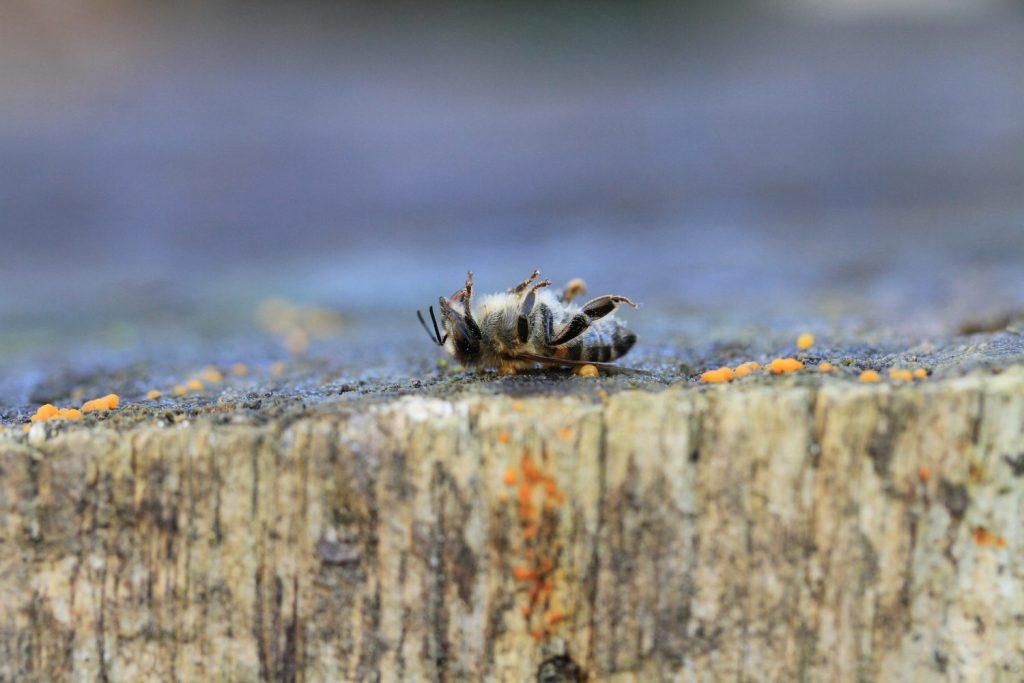
[…] apparatus can assist avoid wasting cash and the surroundings however it calls for warning. Fatal honeybee sicknesses and pests are identified to linger in previous apparatus, and this can be very tricky to resolve or […]